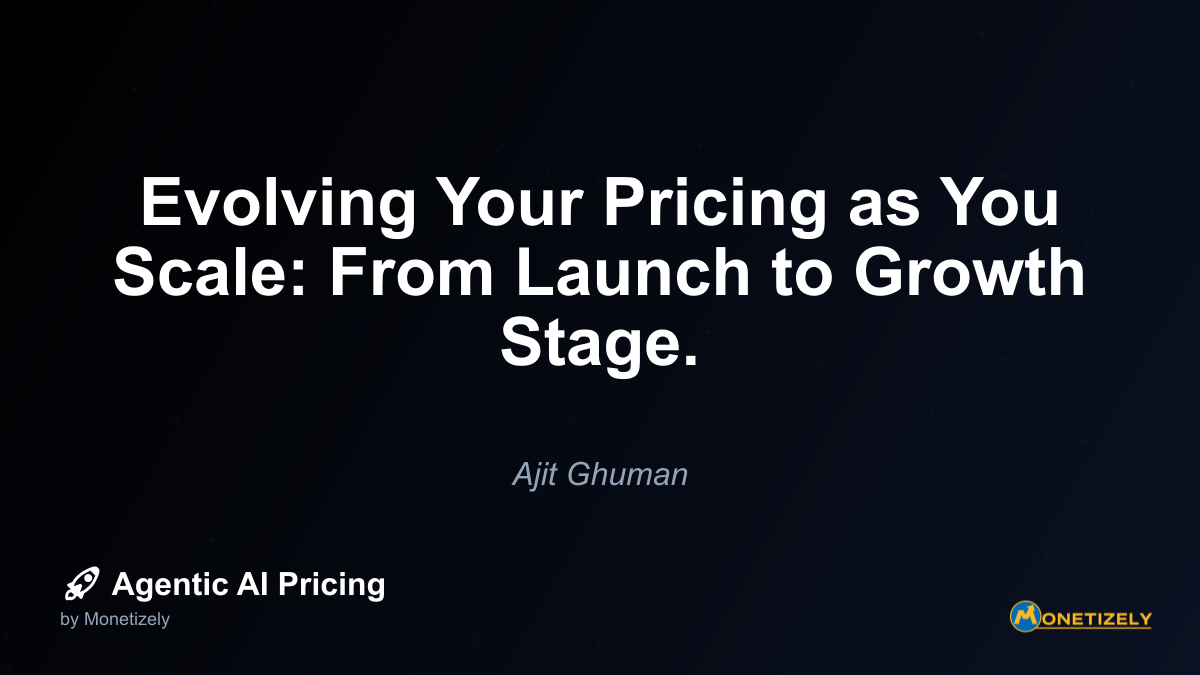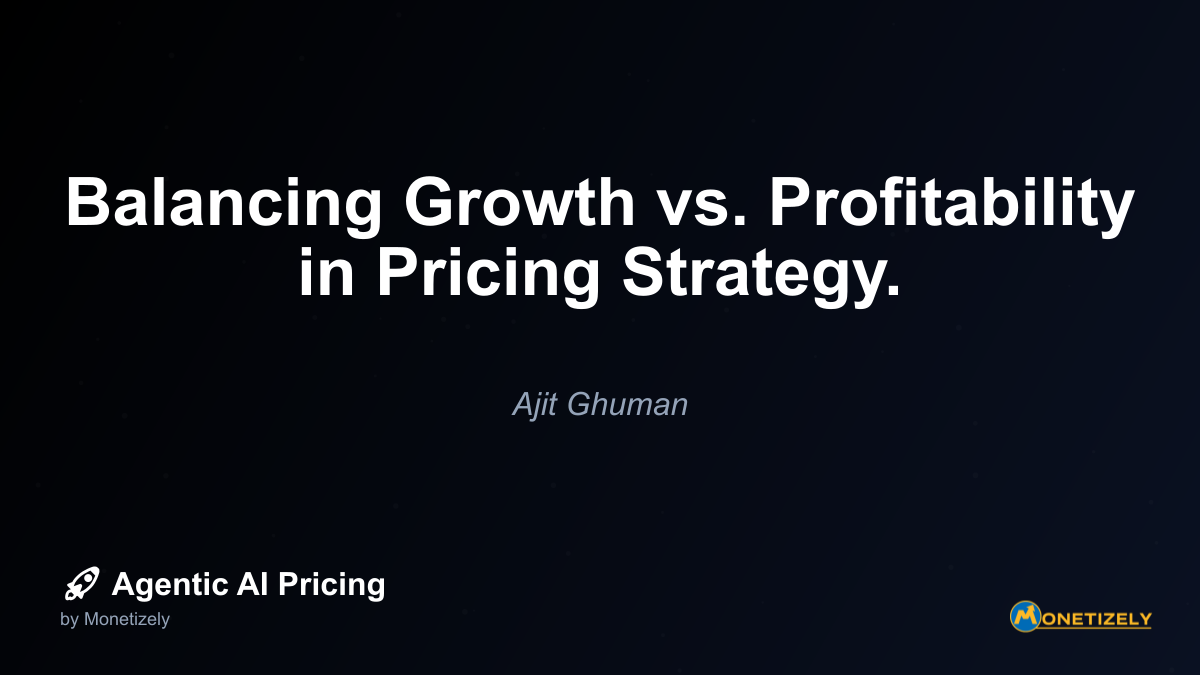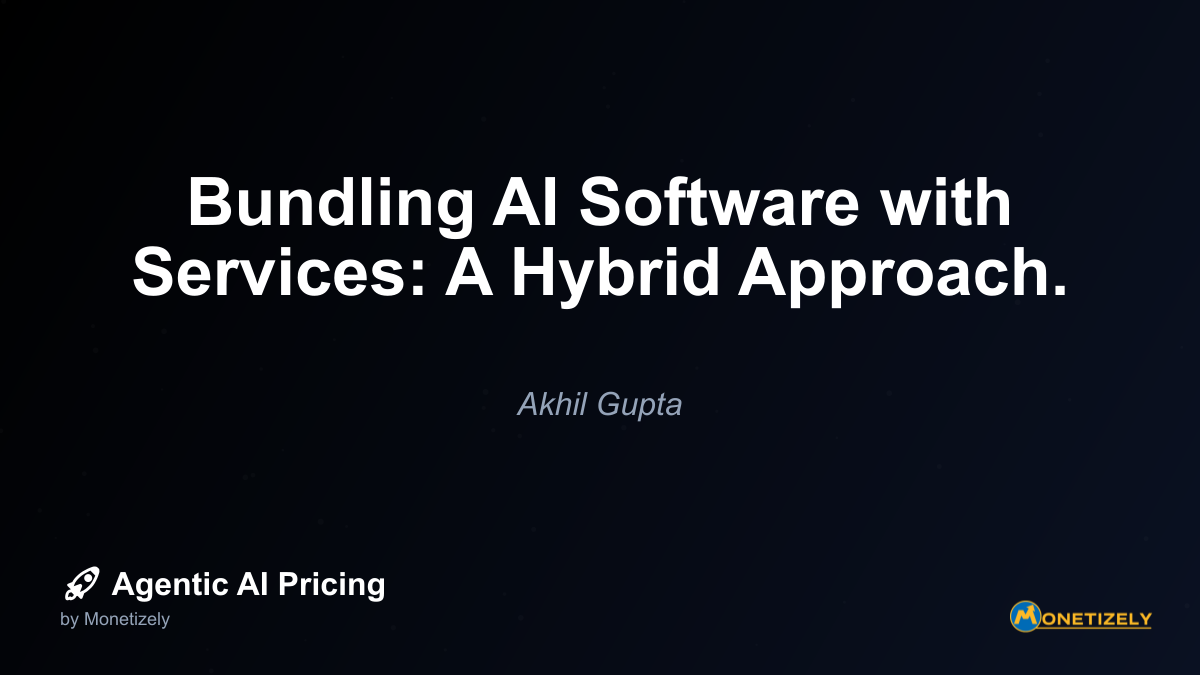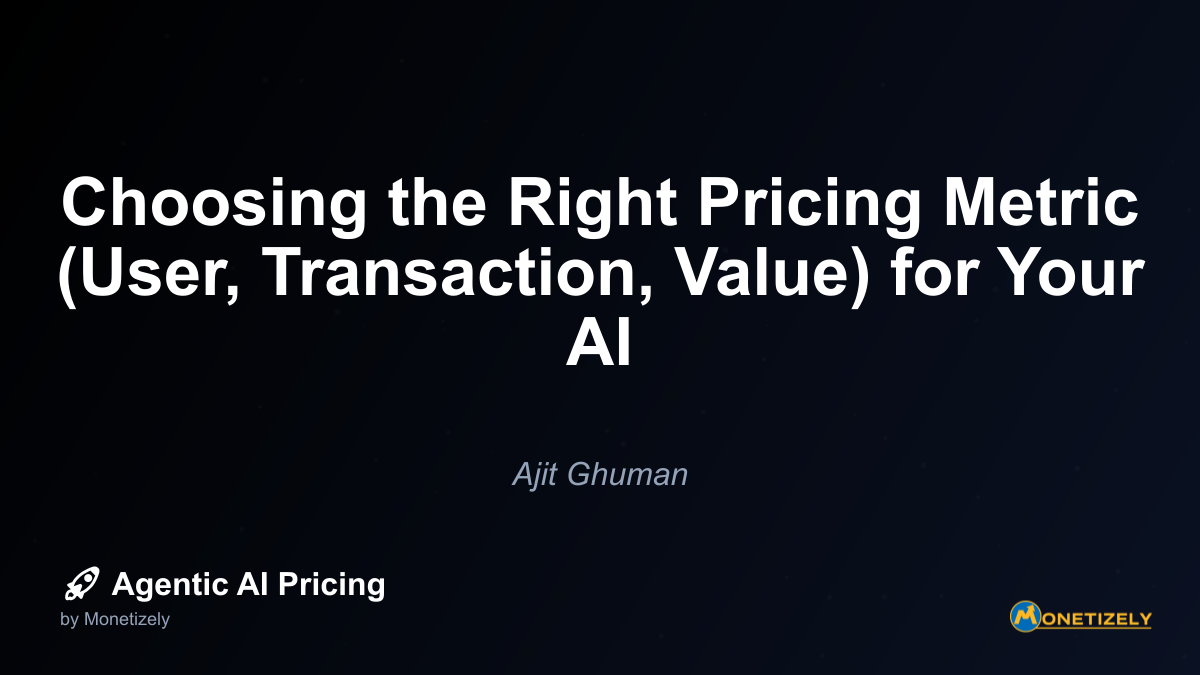· Ajit Ghuman · Strategy & Planning · 8 min read
Evolving Your Pricing as You Scale: From Launch to Growth Stage.
AI and SaaS Pricing Masterclass
Learn the art of strategic pricing directly from industry experts. Our comprehensive course provides frameworks and methodologies for optimizing your pricing strategy in the evolving AI landscape. Earn a professional certification that can be imported directly to your LinkedIn profile.

Signs You’ve Reached the Growth Stage
- Consistent revenue growth month-over-month
- Established product-market fit with predictable retention
- Expanding team size and specialization
- Increasing market recognition and competitive pressure
- Diversifying customer segments
Pricing Evolution During Growth Stage
During the growth stage, your pricing strategy should become more sophisticated, addressing different market segments and maximizing revenue from your most valuable customers.
Tier Expansion and Upmarket Movement
Many successful SaaS companies add higher-priced tiers during the growth stage to capture more value from enterprise customers. This “land and expand” strategy allows you to maintain accessible entry points while creating upgrade paths for larger clients.
Zoom followed this pattern perfectly. They maintained simple pricing for individuals and small teams while developing robust enterprise offerings with advanced security, administration, and integration capabilities at significantly higher price points.
Value-Based Price Increases
As your product matures and delivers more value, strategic price increases become essential. Research from Price Intelligently suggests that a mere 1% improvement in pricing can yield an 11% increase in operating profit—far more impact than 1% improvements in acquisition, retention, or variable costs.
When implementing price increases:
- Grandfather existing customers (at least temporarily)
- Clearly communicate the additional value that justifies the increase
- Provide advance notice and transition periods
- Consider segmenting increases by customer type or usage level
Expansion Revenue Focus
Growth-stage companies shift focus from initial acquisition to expanding revenue within the existing customer base. This includes:
- Cross-selling additional products or modules
- Creating add-ons for specialized functionality
- Implementing usage-based components that grow with customer success
- Developing professional services or implementation packages
Salesforce mastered this approach, continuously adding new “clouds” (products) that existing customers could adopt, dramatically increasing their average revenue per account over time.
Localization and Market-Specific Pricing
As you expand internationally, uniform global pricing becomes increasingly problematic. Growth-stage companies typically implement:
- Regional pricing adjustments based on purchasing power
- Currency-specific pricing to reduce exchange rate friction
- Localized billing methods and payment terms
- Market-specific packaging in some cases
Key Metrics During Growth Stage
Your pricing metrics should become more sophisticated during growth:
- Net revenue retention (NRR) - measuring expansion within existing accounts
- Average revenue per account (ARPA) - tracking monetization effectiveness
- Customer lifetime value by segment (LTV) - identifying your most valuable customers
- Price realization (actual vs. list price) - monitoring discounting discipline
- Expansion MRR - measuring upsell and cross-sell success
The central question evolves to: “How can we optimize our pricing structure to maximize long-term customer value while maintaining growth?”
Maturity Stage: Optimizing for Profitability and Defensibility
As your company reaches maturity, pricing strategy shifts again—this time toward optimizing profitability while defending against competitive threats and market commoditization.
Signs You’ve Reached Maturity Stage
- Slowing growth rates in core markets
- Increasing investor focus on profitability metrics
- Established brand and market position
- Sophisticated product with multiple offerings
- Pressure from lower-cost alternatives
Pricing Evolution During Maturity Stage
Mature companies employ several pricing strategies to maintain growth and profitability:
Value-Chain Expansion
Rather than simply raising prices, mature companies often expand across the value chain, developing new products that address adjacent customer needs. This creates natural cross-sell opportunities and increases switching costs.
Adobe’s transformation from selling individual creative software licenses to the Creative Cloud subscription exemplifies this approach. They expanded from point solutions to an integrated ecosystem, significantly increasing customer lifetime value while creating defensibility against competitors.
Price Optimization Through Segmentation
Mature companies invest heavily in understanding different customer segments’ price sensitivity and willingness to pay. This enables highly optimized pricing that extracts maximum value from each segment.
Techniques include:
- Behavioral segmentation based on usage patterns
- Industry-specific packaging and pricing
- Company-size based differentiation
- Regional pricing optimization
- Usage-based component refinement
Bundling and Unbundling Strategies
Strategic bundling (combining products at a discount) and unbundling (breaking solutions into separately priced components) become powerful tools at maturity.
Microsoft’s evolution with Office and Microsoft 365 demonstrates both approaches. They unbundled certain enterprise capabilities for specialized users while creating compelling bundles for general business customers.
Loyalty-Based Pricing
Mature companies often implement sophisticated loyalty pricing to reduce churn and increase lifetime value:
- Multi-year contract incentives
- Volume-based discounting programs
- Usage commitment discounts
- Renewal incentives
- Customer success-linked pricing
Key Metrics During Maturity Stage
At maturity, pricing metrics focus on efficiency and profitability:
- Gross and net dollar retention
- Customer acquisition cost efficiency
- Pricing power (ability to increase prices without losing customers)
- Competitive win/loss rates by segment
- Customer profitability analysis
The central question becomes: “How can we optimize our pricing to maximize profitability while defending against competitive threats and market changes?”
When and How to Evolve Your Pricing Strategy
Knowing when to evolve your pricing is as important as understanding how. Here are key triggers that should prompt pricing reassessment:
Significant Value Proposition Changes
When you’ve substantially improved your product’s value delivery, your pricing should reflect this. Signs include:
- Addition of high-value features or capabilities
- Significant improvement in core metrics (e.g., performance, reliability)
- New integrations that enhance workflow
- Expansion of use cases or addressable problems
Market Position Shifts
As your market position evolves, so should your pricing:
- Increasing brand recognition and trust
- Growing reference customer base
- Analyst recognition (e.g., Gartner, Forrester)
- Establishment as a category leader
Competitive Landscape Changes
External market factors often necessitate pricing evolution:
- New competitors entering at different price points
- Existing competitors changing their pricing models
- Industry consolidation or disruption
- Changing customer expectations about pricing models
Internal Business Evolution
Your own business changes can drive pricing strategy shifts:
- Increasing customer acquisition costs
- Changes in growth targets or investor expectations
- New funding rounds or capitalization
- Strategic pivots or market focus changes
How to Successfully Implement Pricing Changes
Once you’ve determined that pricing evolution is necessary, implementation becomes critical. Failed pricing changes can damage customer relationships and brand perception.
1. Conduct Thorough Research
Before making any change, gather comprehensive data:
- Customer interviews about perceived value
- Competitive pricing analysis
- Usage data correlation with willingness to pay
- Price sensitivity testing
- Financial modeling of various scenarios
2. Segment Your Approach
Rarely should pricing changes apply uniformly across all customers:
- Consider grandfathering existing customers
- Implement changes by segment or cohort
- Create migration paths for different customer types
- Consider regional or industry-specific approaches
3. Communicate Effectively
How you communicate pricing changes dramatically impacts their reception:
- Focus on value delivery, not internal costs
- Provide advance notice (30-90 days typically)
- Train customer-facing teams thoroughly
- Create clear FAQ documents
- Consider executive communication for key accounts
4. Monitor and Adjust
After implementation, closely monitor key metrics:
- Conversion rates at different stages
- Churn spike analysis
- Customer feedback themes
- Competitive win/loss patterns
- Revenue impact against projections
Finding the right balance between profit and growth is especially critical during pricing transitions. While growth-stage companies often prioritize expansion over maximization, your pricing strategy should still drive toward long-term profitability targets.
Case Study: Slack’s Pricing Evolution
Slack provides an excellent case study in pricing evolution through company lifecycle stages:
Launch Stage (2013-2014)
- Generous free tier with search limitations
- Simple per-user pricing model
- Focus on user acquisition and engagement
Validation Stage (2014-2015)
- Introduction of Standard and Plus tiers
- Refinement of free tier limitations
- Per-active-user pricing to align with actual usage
Growth Stage (2015-2018)
- Enterprise Grid introduction for larger organizations
- More sophisticated security and compliance features
- Volume-based discounting
- Annual billing incentives
Maturity Stage (2018-Present)
- Industry-specific solutions and pricing
- Advanced governance and security add-ons
- Partner ecosystem monetization
- Multi-product integration (post-Salesforce acquisition)
At each stage, Slack aligned its pricing with its evolving value proposition, market position, and business objectives.
Common Pricing Evolution Mistakes
As you evolve your pricing strategy, watch for these common pitfalls:
1. Changing Too Frequently
Pricing changes create market friction. Changing more than once annually creates confusion and erodes trust. Plan comprehensive changes rather than incremental adjustments.
2. Focusing Solely on Price Point
Price points receive disproportionate attention, but structure and packaging often matter more. Consider how you package features and what metrics you charge on before simply raising prices.
3. Ignoring Customer Segmentation
Blanket pricing changes rarely make sense. Different customer segments have different price sensitivity and value perception. Segment your approach accordingly.
4. Reactive Competitive Pricing
Matching competitor pricing without understanding your unique value proposition leads to commoditization. Price based on your value delivery, not competitive pressure alone.
5. Neglecting Existing Customers
Focusing pricing optimization solely on new customer acquisition alienates your existing base. Consider grandfathering policies or loyalty benefits for long-term customers.
Preparing for Your Next Pricing Evolution
Regardless of your current stage, you should be gathering data to inform your next pricing evolution. Here’s what to track:
Usage Patterns
- Feature adoption rates
- Usage frequency and depth
- User expansion within accounts
- Correlation between usage and retention
Customer Feedback
- Perceived value surveys
- Feature importance ratings
- Competitive comparison feedback
- Win/loss analysis themes
Market Intelligence
- Competitor pricing changes
- Industry pricing model trends
- Market growth and saturation data
- Adjacent solution pricing
Financial Metrics
- Customer acquisition cost trends
- Lifetime value by segment
- Price realization analysis
- Expansion revenue patterns
Pricing with exit goals in mind becomes increasingly important as you scale. Your pricing strategy significantly impacts valuation metrics like revenue growth rate, gross margin, and customer lifetime value—all critical factors in acquisition scenarios.
Conclusion: Pricing as a Journey, Not a Destination
Pricing strategy is never “done.” It must evolve alongside your product, market position, competitive landscape, and business objectives. The most successful SaaS companies view pricing as a continuous process of refinement rather than a one-time decision.
As you scale from launch through growth stages, your pricing approach should mature from simple acquisition-focused models to sophisticated value-extraction strategies. This evolution requires ongoing investment in customer research, competitive analysis, and pricing expertise.
The companies that master this evolution gain significant competitive advantages: higher retention rates, improved unit economics, and ultimately, superior valuations and market positions. Those that neglect pricing evolution often find themselves stuck with suboptimal models that limit growth or profitability.
Remember that pricing is not merely a financial decision—it’s a core strategic lever that signals your market position, shapes customer perception, and ultimately defines your business trajectory. Invest accordingly in evolving your approach as you scale.
Co-Founder & CEO
Ajit is the author of Price To Scale, a top book on SaaS Pricing and is the Founder of Monetizely. Ajit has led and worked in pricing and product marketing at firms like Twilio, Narvar and Medallia. His work has been featured in Forbes and VentureBeat. Ajit regularly consults with software companies from Seed stage to post-IPO on pricing strategy. Ajit is also a highly-rated co-instructor for 'The Art of SaaS Pricing and Monetization' on Maven.
Pricing Strategy Audit
Let our experts analyze your current pricing strategy and identify opportunities for improvement. Our data-driven assessment will help you unlock untapped revenue potential and optimize your AI pricing approach.




